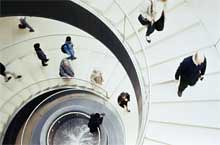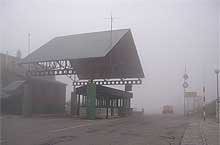Listening to today's news I heard a story about the Department of Homeland Security denying any link between terrorism and a spate of "incidents" involving lasers and commercial aircraft. Apparently people have been "painting" commercial planes with lasers since 1995; to date the Federal Aviation Administration has logged
over 200 incidents. Some of this activity is definitely of a criminal nature. Gangs in California have been "bundling" cheap pointer-lasers (the kind used for presentations) together and using the assembly to interfere with airborne surveillance by police. Id.
The main concern, of course, is that these devices are being used to target commercial planes for terrorists equipped with surface-to-air-missiles. Some sources estimate that there are between five and ten thousand of these missiles which are unaccounted for in the world's arsenals. The effective range of most such weapons likely to be available to terrorists is between 11,000 and 15,000 feet. "Since that's far lower than the 40,000 feet airliners normally cruise at, terrorists must fire off the weapon while planes are taking off or landing." A terrorist might use the lasers to find out if his intended target is within range. Given the difficulties apparently involved in using these weapons, that seems entirely plausible:
During the Yom Kippur war of 1973, according to a U.S. Air Force report, Arab armies fired more than 5,000 SA-7 rounds against Israeli Air Force ground-attack aircraft, but shot down only 30 planes. Even today, as a general rule, the best soldiers trained in the missile's use only hit about 70 percent of their targets in combat. And civilian jumbo jets, while bigger and slower-moving than fighters, can actually be harder to bring down with shoulder-fired missiles, since they can usually still fly after losing one or two engines. Of those aforementioned 42 attempts against non-military aircraft, about a dozen were successful. But only twice have larger commercial passenger jets been brought down--once in 1993, when Abkhazian rebels in Georgia shot down a Russian airliner, killing 106 passengers; and once in 1983, when UNITA rebels in Angola claimed to have bought down another such aircraft, killing 130.Id.Commercially-available lasers are relatively inexpensive and can paint objects at distances up to 3,600 feet. I found two online for illustration purposes here and here. And I don't see why someone with a sophisticated electronics background couldn't adapt a more powerful laser, perhaps one specially developed for surveyors or light shows, to the same purpose.
There are entirely-innocent explanations for some of these incidents. One, for example, involves amateur astronomers using laser devices to point out stars. And the usual suspect, jackassery, can't be ruled out; witness this story about an idiot who apparently thought to impress his seven-year old daughter by trying something that could crash an airplane. Another story illustrates how serious that kind of "prank" can be:
On Oct. 30, 1995, the pilot of a Southwest Airlines flight departing from McCarran International Airport in Las Vegas reported that a laser beam sweeping through the cockpit caused him to be temporarily blinded.Having read all that, I still have some questions about this phenomenon.
The pilot could not focus or interpret any instrument indications and was disoriented for several minutes, so the other pilot in the cockpit took control of the aircraft.
First, why would a major power (these missiles are made by Russia, China, France, Japan, Germany, and others) design and issue a shoulder-fired surface-to-air missile that has no rangefinder, and obliges the user to provide his own home-grown item? I realize that the older versions are heat-seeking, and not laser-guided, but anyone using them would still want to know if his target was within range of the heat-seeking device before he fired. I suspect, however, that older models may have used some kind of iron or optical sight, or a combination, and that a new laser rangefinder might be what's needed to "make assurance doubly sure." Most of the guys we're worried about were educated in madrassas, and while they can tell you how many djinn are carrying the Great Satan's 747 through the air, they're probably not all that good at the math needed to bring it down.
Second, why not try and shoot one down? Either the people we're worrying about have usable surface-to-air missiles or they don't. While the 911 attack was planned for years, I can't see the nine-years between 1995 and 2004 as being some kind of lull during which the terrorists were (or still are) planning a large-scale attack outside of multiple U.S. airports. I think it should be borne in mind that every time stories like this are reported, not a few of our countrymen are tempted to jackassery; perhaps this is just a self-perpetuating series of events.
Paul Rantacore, the Deputy Chairman of the Security Commitee for the Allied Pilots Association, was quoted in the L.A. Times story referenced above as saying,"It's not some kid. It's too organized." The article didn't say what he based that assessment on. Given our rates of airline traffic (50,000 commercial flights per day in the United States), 200 "hits" over a nine-year period seems to indicate this is the result of random jackassery rather than a well-organized campaign to do . . . well . . . nothing.
Another possibility that occurs to me is that this isn't mere jackassery, but terrorist jackassery, namely the use of lasers merely to raise a little havoc and, perhaps, blind one or two of the Great Satan's air pirates in the name of Islam. You may want to kill Hitler, but that doesn't mean you'd turn up your nose at the idea of keying his car's paint, so to speak. Just as there are American jackasses who think it's fun to screw around with air traffic, I'm sure there are foreign jackasses who'd do it for a much "holier" motive.
Lastly, it's worth noting that terrorists don't need expensive shoulder-fired missiles to screw around with air traffic. All they really need is a van with a hole cut into the top, a place to park it somewhere within 4,500 - 6,000 feet of a runway approach, and one of these. Given a sufficiently-good marksman, it would be possible to put a single round into a jet's fuselage, tail or -- preferably -- one of its engines. The plane would be grounded and the airport closed, perhaps for days. It would take more days, perhaps even weeks, to rebuild the engine or repair the damage to the plane. (Even if the plane wasn't seriously damaged, it would still have to be grounded and given a thorough inspection). With our search-and-seizure laws it's doubtful the government could actually secure a space 6,000 feet around every airport-approach lane in the U.S. Perhaps that's what the rangefinders are for, if the terrorists are using them.











No comments:
Post a Comment